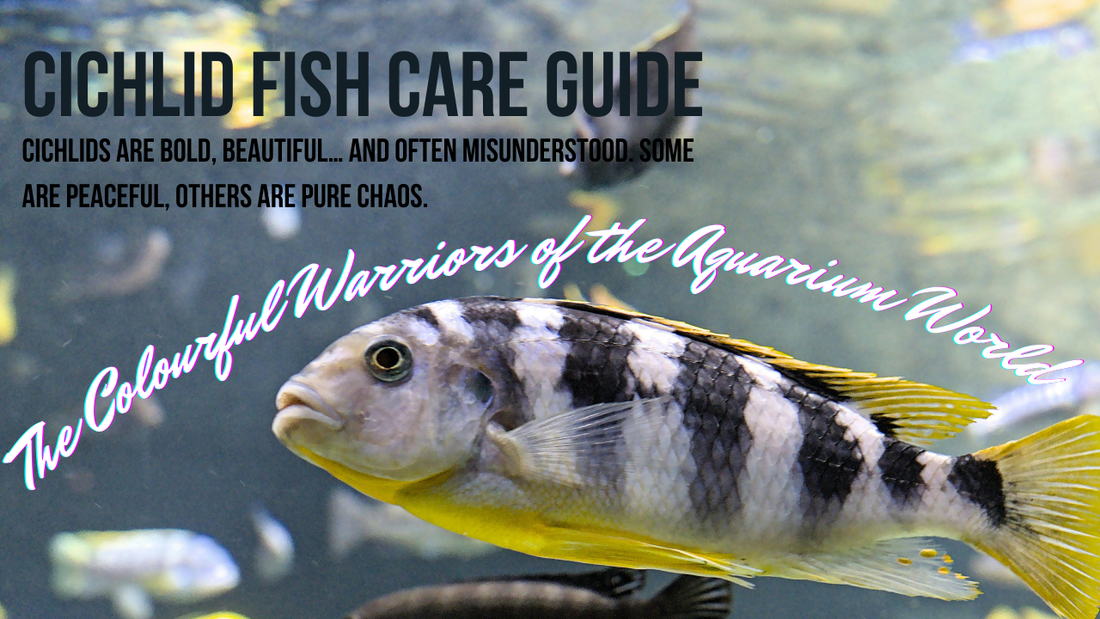Cichlid Fish Care Guide – The Colourful Warriors of the Aquarium World
Cichlids are bold, beautiful… and often misunderstood. Some are peaceful, others are pure chaos. But if you know what you're doing, they can be the most rewarding fish you’ll ever keep.
🗺️ Origin, History & Appearance
Cichlids (family Cichlidae) are one of the most diverse freshwater fish families in the world, with over 1,300 described species and hundreds more yet to be named. They’re found across Africa, South America, Central America, and parts of Asia, each adapted to different environments from rift lakes to muddy riverbeds.
Most cichlids are known for:
- Powerful bodies and vivid color patterns
- Highly territorial or aggressive behavior
- Complex parenting instincts
- Rapid evolutionary adaptation (especially in African lakes)
They come in a huge range of sizes : from the tiny Ram Cichlid (3 cm) to the mighty Oscar (35 cm).
🧬 Varieties of Cichlids – Types, Traits, and Comparison

Cichlids are categorized based on geography and behavior. Here's a quick breakdown:
🧭 African Cichlids
|
Group |
Example Species |
Key Traits |
|
Lake Malawi |
Electric Yellow Lab (Labidochromis caeruleus), Peacocks (Aulonocara) |
Bright colors, active, aggressive |
|
Lake Tanganyika |
Frontosa (Cyphotilapia frontosa), Tropheus |
Complex behavior, needs hard alkaline water |
|
Lake Victoria |
Haplochromis species |
Rare in trade, often territorial |
🌎 American Cichlids
|
Region |
Popular Species |
Key Traits |
|
South America |
Oscar, Discus, Severum, Apistogramma |
Intelligent, social, complex parenting |
|
Central America |
Convict Cichlid, Jack Dempsey, Firemouth |
Aggressive, hardy, fast breeders |
🌍 Indian/Asian Cichlids
- Etroplus suratensis (Green Chromide): Found in India & Sri Lanka, brackish and hardy
- Etroplus maculatus (Orange Chromide): Peaceful, small, community-safe
🌿 Natural Habitat & Diet in the Wild
Cichlids inhabit rocky lake beds, slow-moving streams, muddy rivers, and even brackish estuaries. Most species are found near structure and use rocks, caves, and roots for hiding and nesting.
Their natural diet varies:
- Omnivores (Peacocks, Severums): plants, insects, algae
- Carnivores (Oscars, Jack Dempsey): fish, crustaceans, worms
- Herbivores (Mbuna): biofilm, algae, veggies
Understanding your cichlid’s native habitat helps tailor their care and tank setup accurately.
🏠 What Tank Size Does a Cichlid Need?
Because of their territorial nature, most cichlids need larger tanks than their size would suggest.
|
Cichlid Type |
Minimum Tank Size |
|
Dwarf Cichlids (Rams, Apistos) |
20 gallons |
|
African Mbuna (group) |
40–55 gallons |
|
Oscars, Severums |
55–75 gallons |
|
Frontosa, larger species |
100+ gallons |
More space means less aggression and more natural behavior.
💧 Water Parameters
Cichlids come from both soft and hard water zones. Here's a general guide:
|
Type |
Temp |
pH |
Hardness |
|
African (Malawi, Tanganyika) |
24–28°C |
7.8–8.5 |
Hard |
|
South American (Oscar, Discus) |
26–30°C |
6.0–7.5 |
Soft |
|
Central American |
24–28°C |
7.0–8.0 |
Medium |
|
Indian |
24–28°C |
6.5–7.5 |
Medium |
✅ Add crushed coral or Indica Additives for buffering in African setups.
✅ Use Life AAYU Nutro Fit Plus to help adapt soft water fish to Indian tap water.
🧠 Behavior – Territorial, Intelligent, Emotional
Cichlids are among the smartest freshwater fish. They:
- Recognize owners
- Rearrange tank décor
- Dig, claim, and defend territory
- Display emotions like stress, curiosity, and excitement
Some cichlids can cohabitate peacefully in groups (e.g., African Mbuna), while others are best kept in pairs or solo.
Their complex personalities make them great for observation but, not for casual keepers.
🐠Tank Setup & Décor
Essentials:
- Rocks, caves, driftwood for territory
- Open swimming space
- Sand or fine gravel (many cichlids dig)
- Strong filtration (Oscars are messy!)
For African cichlids, go with rocky aquascapes and minimal plants.
For South American cichlids, choose planted tanks with soft lighting and leaf litter.
⏳ Lifespan & Growth
- Dwarf Cichlids: 3–5 years
- Most Central/African Cichlids: 6–10 years
- Oscars & Discus: 10–15 years with great care
Growth is fast, especially with high-protein food and clean water.
👨👩👧👦 Tank Mates – Can They Live Together?
✅ Best with:
- Same-region cichlids with matching temperament
- Large tetras, plecos, rainbowfish (in big tanks)
- Fast or armored fish
❌ Avoid:
- Long-finned or slow fish (angels, gouramis)
- Small community fish (neons, guppies)
- Mixing African and South American cichlids
The secret? Understand species aggression levels, space needs, and feeding zones.
🧫 Common Diseases and Prevention
- Hole in the Head (HITH) – from poor diet, water
- Bloat – often from wrong food (e.g., feeding protein to herbivores)
- Ich and fin rot – stress, temp issues
✅ Prevent with:
- Weekly water changes
- Targeted feeding (herbivores vs. carnivores)
- Life AAYU Nutro Fit Plus for internal parasite prevention and improved digestion
🍽️ Best Food for Cichlids
Tailor your food to their natural diet:
Life Aayu Cichlid Regular Fish Food:

Key Features:
✅ Immunity Booster & Digestion-Friendly.
✅ Natural & Handmade with Ayurvedic Ingredients.
✅ Clinically Proven Content.
✅ Keeps Water Clean.
♀️♂️ How to Tell Male from Female Cichlids
Varies by species, but general clues:
|
Trait |
Male |
Female |
|
Color |
Brighter |
Duller |
|
Size |
Larger |
Smaller, rounder |
|
Fins |
Longer, more pointed |
Rounded |
|
Behavior |
More territorial |
Protective of fry (if parenting) |
🐣 Breeding Cichlids
Most cichlids are excellent parents:
- Oscars, Convicts, Apistos are substrate spawners
- Africans (like Mbuna) are mouthbrooders
- Discus practice fry nursing by secreting skin mucus
Set up separate breeding tanks, use flat rocks or caves, and watch for spawning signs like pairing and territory defense.
🎨 Coloration and Mood
Color intensity reflects:
- Health
- Mating readiness
- Territorial mood
Bright = confident and dominant
Faded = stressed, sick, or submissive
Flashing/scratching = may indicate parasites
💡 Unique Aspects & Final Tips
- Cichlids are the most intelligent freshwater fish group
- Many species “dig pits” to spawn or mark territory
- They need mental stimulation – rearrange décor monthly
- Best kept by hobbyists who want personality, not passivity
📩 Need Help Choosing or Keeping Cichlids?
💬 Write to us at info@mayurdevaquascaper.com
📍 Visit our Mumbai gallery to explore (GSM Aquarium Products India LLP)
🛒 Buy specialized food, decorations and supplements from AquariumProductsIndia.in



